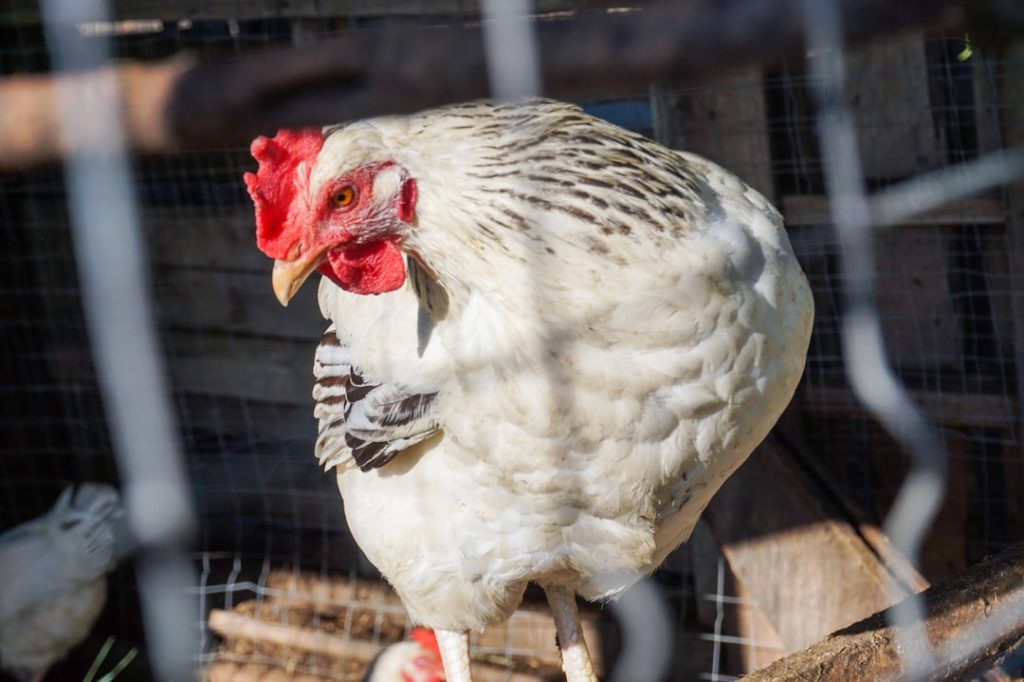Chickens are naturally curious and social animals that exhibit a range of behaviors important for their survival and social structure. They actively search for food and explore their environment, displaying territorial tendencies by establishing and defending specific areas. Understanding these innate behaviors is essential for effectively managing chicken populations and deterring them from unwanted locations.
Chickens possess heightened sensitivity to environmental changes, reacting strongly to sudden movements and loud noises. This characteristic can be utilized in developing strategies to keep chickens away from particular areas. Their social structure is based on a hierarchical system known as the pecking order, where dominant birds assert control over resources and territory, influencing the behavior of subordinate members within the flock.
The pecking order plays a significant role in flock dynamics, affecting how chickens interact with their environment and each other. Dominant birds often claim preferred areas, with subordinate chickens following their lead. This social hierarchy must be considered when implementing deterrent measures, as it can impact the effectiveness of various strategies.
By comprehending the natural behaviors, social dynamics, and environmental sensitivities of chickens, it becomes possible to develop more effective and humane methods for managing their presence in specific areas. This knowledge contributes to creating a balanced coexistence between humans and chickens, allowing for better control and management of these domesticated birds.
Table of Contents
- 1 Creating physical barriers to deter chickens
- 2 Using natural repellents to keep chickens away
- 3 Implementing noise and visual deterrents
- 4 Providing alternative areas for chickens to roam
- 5 Consistently reinforcing boundaries and training
- 6 Seeking professional advice for persistent issues
- 7 FAQs
- 7.1 What are some effective ways to keep chickens off the back porch?
- 7.2 Why is it important to keep chickens off the back porch?
- 7.3 Are there any natural deterrents that can be used to keep chickens off the back porch?
- 7.4 How can I train my chickens to stay away from the back porch?
- 7.5 What are some potential risks of having chickens on the back porch?
Key Takeaways
- Chickens are naturally curious and will explore their surroundings
- Fences and netting can be effective physical barriers to keep chickens out of certain areas
- Plants such as marigolds and lavender can act as natural repellents for chickens
- Scarecrows and reflective objects can deter chickens with noise and visual stimuli
- Designating a specific area for chickens to roam freely can help keep them away from unwanted areas
- Consistent reinforcement and training is key to maintaining boundaries with chickens
- If issues persist, seeking professional advice from a veterinarian or animal behaviorist is recommended
Creating physical barriers to deter chickens
Visual Cues and Natural Barriers
Physical barriers can also serve as a visual cue for chickens, signaling that they are not allowed in a particular area. Another approach to creating physical barriers is by utilizing natural landscaping features such as hedges or shrubs to create a natural boundary that deters chickens from entering specific areas. These natural barriers not only serve as a physical obstacle but also blend seamlessly into the surrounding environment, creating a more aesthetically pleasing solution to deterring chickens.
Effective Management of Chicken Movement
By incorporating physical barriers into the landscape, it becomes possible to effectively manage the movement of chickens and prevent them from encroaching on unwanted areas. In addition to traditional fencing and natural barriers, the use of chicken wire or mesh can also be an effective way to create physical barriers that deter chickens. These materials can be strategically placed to block off access points or create enclosures that limit the chickens’ ability to roam freely.
Maintaining Harmony with Chickens
By implementing physical barriers in the form of fencing, netting, or natural landscaping features, it becomes possible to effectively deter chickens from unwanted areas and maintain a harmonious coexistence with these animals.
Using natural repellents to keep chickens away

In addition to physical barriers, natural repellents can also be used to deter chickens from unwanted areas. Certain scents and tastes are known to be unpleasant to chickens and can be utilized as a means of keeping them at bay. For example, the scent of citrus fruits or the taste of hot peppers can act as natural repellents that discourage chickens from entering specific areas.
By strategically placing these natural repellents around the perimeter of a garden or other sensitive areas, it becomes possible to create a deterrent that dissuades chickens from causing damage or disturbance. Another natural repellent that can be used to keep chickens away is the scent of certain herbs or plants that are known to be unappealing to them. For example, the strong aroma of lavender or rosemary can act as a natural deterrent that discourages chickens from entering specific areas.
By incorporating these plants into the landscape or using their essential oils as a spray, it becomes possible to create a natural barrier that deters chickens from causing damage or disturbance. Furthermore, the use of reflective surfaces such as mirrors or shiny objects can also serve as a natural repellent that deters chickens from entering specific areas. The reflection of light off these surfaces can startle and confuse chickens, making them less likely to approach or enter certain spaces.
By strategically placing reflective surfaces around sensitive areas, it becomes possible to create a natural deterrent that dissuades chickens from causing damage or disturbance.
Implementing noise and visual deterrents
In addition to physical barriers and natural repellents, noise and visual deterrents can also be effective in deterring chickens from unwanted areas. Loud noises such as clapping or banging pots can startle and discourage chickens from entering specific spaces. By using these noise deterrents strategically, it becomes possible to create an aversive stimulus that dissuades chickens from causing damage or disturbance.
Another effective visual deterrent is the use of scarecrows or other decoy animals that mimic predators and discourage chickens from entering specific areas. The presence of these visual deterrents can create a sense of danger for the chickens, making them less likely to approach or enter certain spaces. By strategically placing scarecrows or decoy animals around sensitive areas, it becomes possible to create a visual deterrent that dissuades chickens from causing damage or disturbance.
Furthermore, the use of motion-activated devices such as sprinklers or lights can also serve as effective noise and visual deterrents that discourage chickens from entering specific areas. The sudden activation of these devices can startle and deter chickens, making them less likely to approach or enter certain spaces. By strategically placing motion-activated devices around sensitive areas, it becomes possible to create an aversive stimulus that dissuades chickens from causing damage or disturbance.
Providing alternative areas for chickens to roam
One effective strategy for deterring chickens from unwanted areas is by providing alternative spaces for them to roam and explore. By creating designated areas where chickens are allowed to roam freely, it becomes possible to redirect their attention away from sensitive or off-limits spaces. This approach not only provides a solution for deterring chickens but also ensures that they have ample space to exhibit their natural behaviors without causing damage or disturbance.
Another way to provide alternative areas for chickens is by creating designated feeding and watering stations away from sensitive areas. By establishing clear locations for food and water, it becomes possible to attract chickens to specific spaces while keeping them away from off-limits areas. This approach not only provides an alternative focus for the chickens but also helps in managing their movements and behaviors.
Furthermore, the use of chicken coops or enclosures can also serve as alternative spaces for chickens to roam and explore. By providing secure and spacious enclosures for the birds, it becomes possible to limit their access to sensitive areas while allowing them to exhibit their natural behaviors in a controlled environment. This approach not only provides a solution for deterring chickens but also ensures their safety and well-being.
Consistently reinforcing boundaries and training

Establishing Clear Expectations
This can be achieved through regular reinforcement of physical barriers, natural repellents, noise and visual deterrents, as well as providing alternative areas for the birds to roam.
The Role of Training
Training can also play a crucial role in deterring chickens from unwanted areas. By using positive reinforcement techniques such as rewards for desired behaviors and redirection for undesired behaviors, it becomes possible to train the birds to respect boundaries and avoid sensitive areas. This approach not only helps in deterring chickens but also fosters a positive relationship between humans and the birds.
Maintenance and Upkeep
Furthermore, regular maintenance and upkeep of physical barriers, natural repellents, noise and visual deterrents, as well as alternative spaces for the birds are essential in consistently reinforcing boundaries and training the birds. By regularly inspecting and maintaining these deterrents, it becomes possible to ensure their effectiveness in deterring chickens from unwanted areas.
Seeking professional advice for persistent issues
In some cases, persistent issues with deterring chickens may require professional advice and intervention. If traditional deterrent methods have proven ineffective in managing the behavior of the birds, seeking the expertise of professionals such as animal behaviorists or poultry specialists may be necessary. These professionals can provide valuable insights and recommendations for addressing persistent issues with deterring chickens from unwanted areas.
Additionally, consulting with local agricultural extension services or poultry organizations can also provide valuable resources and support for managing persistent issues with deterring chickens. These organizations often offer educational materials, workshops, and consultations that can help in addressing specific challenges related to chicken behavior and management. Furthermore, seeking professional advice for persistent issues with deterring chickens may also involve collaborating with local farmers or poultry owners who have experience in managing similar challenges.
By networking with individuals who have firsthand experience with chicken behavior and management, it becomes possible to gain valuable insights and practical solutions for addressing persistent issues. In conclusion, understanding the behavior of chickens is crucial in effectively deterring them from unwanted areas. By recognizing their natural tendencies and social dynamics, it becomes possible to devise strategies that take into consideration their behaviors and tendencies.
Creating physical barriers such as fencing, netting, or natural landscaping features can effectively deter chickens from accessing specific spaces. Additionally, using natural repellents such as scents, tastes, and reflective surfaces can discourage chickens from entering sensitive areas. Implementing noise and visual deterrents such as loud noises, scarecrows, or motion-activated devices can startle and deter chickens from causing damage or disturbance.
Providing alternative areas for chickens to roam and consistently reinforcing boundaries through training are essential in managing their behavior. In cases of persistent issues, seeking professional advice from animal behaviorists, poultry specialists, agricultural extension services, or experienced poultry owners may be necessary for addressing specific challenges related to deterring chickens from unwanted areas.
If you’re looking for more tips on keeping chickens away from your back porch, you might be interested in an article on Poultry Wizard about whether geese can eat chicken feed. Check it out here.
FAQs
What are some effective ways to keep chickens off the back porch?
Some effective ways to keep chickens off the back porch include installing physical barriers such as fences or chicken wire, using repellents such as citrus peels or vinegar, and training the chickens to stay away using positive reinforcement.
Why is it important to keep chickens off the back porch?
Keeping chickens off the back porch is important to maintain a clean and sanitary living space, prevent damage to property, and reduce the risk of potential health hazards associated with chicken droppings and feathers.
Are there any natural deterrents that can be used to keep chickens off the back porch?
Yes, natural deterrents such as citrus peels, vinegar, or cayenne pepper can be effective in keeping chickens off the back porch. These natural substances are unpleasant to chickens and can discourage them from venturing onto the porch.
How can I train my chickens to stay away from the back porch?
You can train chickens to stay away from the back porch by using positive reinforcement techniques such as rewarding them for staying in designated areas, and gently guiding them away from the porch when they approach it.
What are some potential risks of having chickens on the back porch?
Having chickens on the back porch can pose risks such as unsanitary conditions, damage to property, and potential health hazards from chicken droppings and feathers. It can also lead to nuisance behavior such as pecking or scratching at furniture and plants.
Meet Walter, the feathered-friend fanatic of Florida! Nestled in the sunshine state, Walter struts through life with his feathered companions, clucking his way to happiness. With a coop that’s fancier than a five-star hotel, he’s the Don Juan of the chicken world. When he’s not teaching his hens to do the cha-cha, you’ll find him in a heated debate with his prized rooster, Sir Clucks-a-Lot. Walter’s poultry passion is no yolk; he’s the sunny-side-up guy you never knew you needed in your flock of friends!







